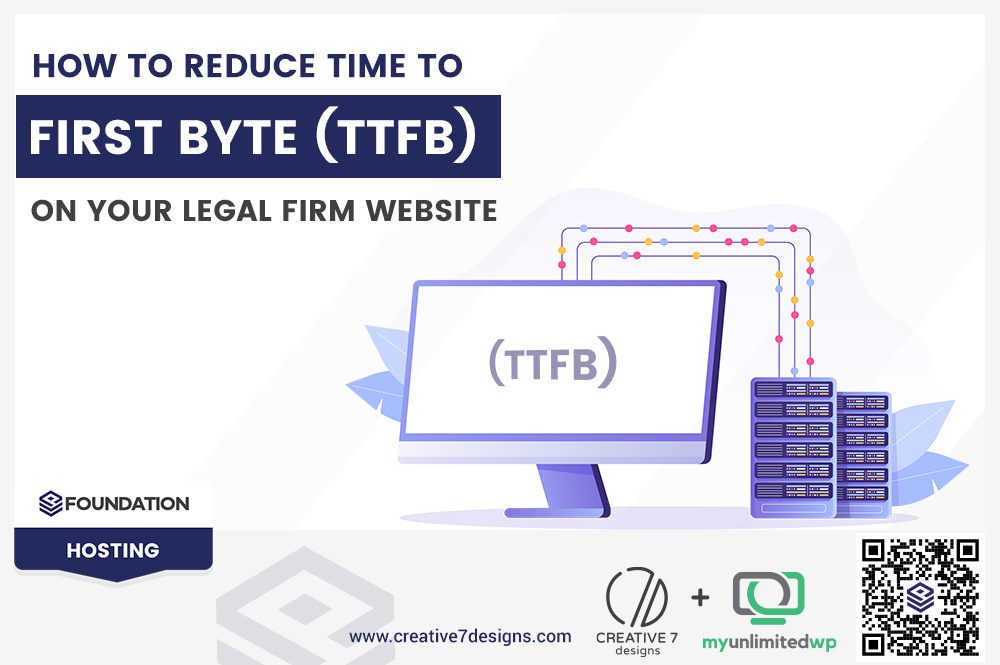Overview: Improve your legal website’s performance and SEO! Discover how to reduce Time to First Byte (TTFB) with smart hosting, caching, and WordPress optimization. Read on!
When potential clients visit your law firm’s website, speed matters — and not just for user experience. One of the most critical speed metrics is Time to First Byte (TTFB), which measures how quickly your server sends the first byte of data in response to a user’s request.
In simpler terms? TTFB is the digital version of a first impression. If your website hesitates, potential clients might too.
Why TTFB Matters for Law Firms
Law firm websites often contain essential information: legal services, case types, attorney bios, consultation forms, and blog posts. But if your site lags — especially when someone needs help fast — it can cost you credibility and cases. Google also considers TTFB when ranking your site in search results, so a faster site supports your SEO efforts.
1. Choose a Premium Hosting Provider
Cheap hosting plans often mean shared servers and slow response times. For legal websites where professionalism is key, invest in reliable hosting with solid infrastructure. Look for hosts offering:
-
SSD-based servers
-
PHP 8.x+ support
-
HTTP/2 or HTTP/3 compatibility
-
Server-level caching
2. Use a Content Delivery Network (CDN)
A CDN distributes your website across a network of servers around the world. When someone visits your site, the server closest to them delivers the content — speeding up TTFB significantly. Cloudflare, BunnyCDN, and KeyCDN are excellent options for law firms wanting to enhance their site’s geographic reach and speed.
3. Optimize Your WordPress Configuration
Many legal firm websites run on WordPress, but default settings can lead to sluggish server responses.
Improve TTFB by:
-
Disabling unnecessary plugins
-
Cleaning up your database regularly
-
Using a lightweight theme optimized for speed
-
Enabling object caching with plugins like Redis or Memcached
4. Enable Server-Side Caching
Server-side caching stores frequently accessed website data so it can be delivered quickly without regenerating content. This is especially important for high-traffic legal blogs or firm sites with resource libraries.
You can implement server-side caching through:
-
Your web host (SiteGround, WP Engine, etc.)
-
Plugins like WP Rocket or W3 Total Cache
-
Custom configurations for advanced setups
5. Minimize Redirects and Unused Code
Legal websites sometimes have outdated redirect chains (like old practice pages or rebranded URLs). These add unnecessary wait time between requests and slow down TTFB. Audit your site for:
-
Broken links
-
Multiple redirects
-
Unused CSS or JavaScript
-
Outdated tracking scripts
Streamline everything — just like you’d prepare a case file — so only essential data is delivered.
6. Measure TTFB Regularly
Use tools like:
-
Chrome DevTools (under the “Network” tab)
Track improvements and set benchmarks over time. If your TTFB is over 600ms, there’s room for optimization. Ideally, aim for under 200ms.
Final Verdict
A slow-loading law firm website not only affects SEO but also makes a bad impression on potential clients who are already stressed and seeking help. By reducing your TTFB, you’re making your site more accessible, professional, and competitive.
If you don’t have time to manage these tech tweaks yourself — no worries. At MyUnlimitedWP, we specialize in optimizing law firm websites so attorneys can focus on clients, not code!

